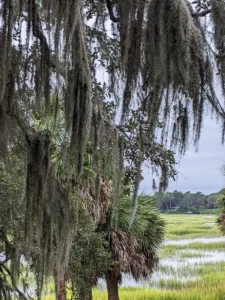
Photos by Luke Frazier
One of the first things I told a friend back in Knoxville about moving to Beaufort was how cool all the Spanish Moss looked draped in the trees around town, and how the more I looked at it, the more I liked how it made me feel: a combination of reverent and enriched. I mentioned it to a local who surprised me with their scoff, saying something about the hassle of having to collect it when it fell and predicting that I would soon “get over it.” Hope not.
Because so far I am not over it, in fact I feel myself sliding deeper into distraction about it. When I ride my bike I’m constantly gazing up as I pass underneath the glorious bounty of Tillandsia usneoides, aka Spanish Moss. The way the light passes through and around it, the ebbing movement and subtle twists, the steady but somehow still dynamic presence it brings, like a memory that keeps returning. When I’m driving, I have to remind myself to pay attention to the road when I’m rolling through one of those canopy-style stretches.
I learned it’s called lots of things from Grandpa’s Beard to Graybeard to Long Moss to Tree Beard. Native peoples called it Itla-okla, which is translated as “tree hair.” Then there is an oft-recounted story about French and Spanish explorers mocking each other’s facial hair and a legend about a Spanish brute chasing a young maiden up a tree and getting stuck. I ended up getting stuck on a long web search about Spanish Moss; surely something this beautiful inspires a lot of creative content?!
Long Moss to Tree Beard. Native peoples called it Itla-okla, which is translated as “tree hair.” Then there is an oft-recounted story about French and Spanish explorers mocking each other’s facial hair and a legend about a Spanish brute chasing a young maiden up a tree and getting stuck. I ended up getting stuck on a long web search about Spanish Moss; surely something this beautiful inspires a lot of creative content?!
Mostly I found botanical descriptions, FAQs, and a few “things you didn’t know” type pieces. Information from these included the fact that it’s not a moss at all but a member of the pineapple family, is not a parasite that harms trees but gets its nutrients and moisture from the air, and that despite persistent beliefs to the contrary, it is not a home for chiggers, aka red bugs (at least when it is on the tree instead of the ground).
I found that chigger-denying claim in a news piece referencing a scientific article in Southeastern Naturalist, quoted by zoology professor Whit Gibbons. Whit went on to describe his little trick of shoving some Spanish Moss into his mouth on field expeditions to show that it changes from gray to green when provided moisture, pointing out, “I have never gotten chiggers when doing this.” I grabbed some moss off a low hanging branch soon after and marveled when it came out of my mouth green. Like Whit, I didn’t get chiggers.
But all the factoids and bug frenzy didn’t capture what was most obvious to me: Spanish Moss is the clearest depiction of what certain kinds of memories would look like if only they had a shape and presence outside our bodies. I’m talking about the kind of memories that haunt your emotions and hunt you down at 3 a.m., the kind that bear down into your tender self, for better or worse. Better when it keeps you in touch with being fully human or reminds you of a loved one, worse when you are struggling with a loss or beating yourself up about something.
 I mean think about it, Spanish Moss is described as ethereal, mystical, enchanting, otherworldly, intriguing, and spectral. It exists in the air, changes colors, drops off on occasion, and can come in bunches. Sounds like memories to me.
I mean think about it, Spanish Moss is described as ethereal, mystical, enchanting, otherworldly, intriguing, and spectral. It exists in the air, changes colors, drops off on occasion, and can come in bunches. Sounds like memories to me.
Memories are part and parcel of the richness of experience and facilitate reflection on both the amazing and tough moments we’ve all gone through. Memories are what hang around and remind us of all the imperfect glory of this here and now world. If you ever witnessed a person losing their memories, you know how sad it is. That’s why, ultimately, memories should be celebrated.
Spanish essayist, poet, and philosopher Miguel de Unamuno connects memory to a spiritual context and recognition of the fluidity of time.
We live in memory, and our spiritual life is at bottom simply the effort of our memory to persist, to transform itself into hope, the effort of our past to transform itself into our future.
This textured thought leads me again to a feeling of reverence and enrichment, like those strands of Spanish Moss. De Unamuno identifies the characteristic that some memories seem to carry—creating hope for a future state. I’m sure it has to do with aging, but after our recent move here I’m even more committed to making the most of the future time I have left. And that includes affirming forays into a mossy state of mind and holding fast to the sustenance of memories, hanging there before us.









